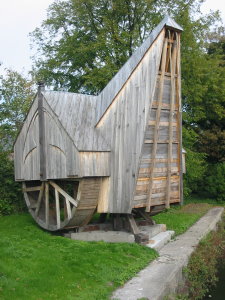During the High Middle Ages, the treadwheel crane was reintroduced on a large scale after the technology had fallen into disuse in western Europe with the demise of the Western Roman Empire. The technology was brought back from the Byzantine Empire by returning crusaders.
The earliest reference to a treadwheel (magna rola) reappears in archival literature in France about 1225, followed by an illuminated depiction in a manuscript of probably also French origin dating to 1240. In navigation, the earliest uses of harbor cranes are documented for Utrecht in 1244, Antwerp in 1263, and Hamburg in 1291, while in England the treadwheel is not recorded before 1331.
Generally, vertical transport was done safer and cheaper by cranes than by customary methods. Typical areas of application were harbors, mines, and, in particular, building sites where the treadwheel crane played a pivotal role in the construction of the lofty Gothic cathedrals.
Nevertheless, both archival and pictorial sources of the time suggest that newly introduced machines like treadwheels or wheelbarrows did not completely replace more labor-intensive methods like ladders, hods and handbarrows. Rather, old and new machinery continued to coexist on medieval construction sites and harbors.
Apart from treadwheels, medieval depictions also show cranes to be powered manually by windlasses with radiating spokes, cranks and by the 15th century also by windlasses
shaped like a ship's wheel. To smooth out irregularities of impulse and get over dead-spots
in the lifting process
flywheels are known to be in use as early as 1123.

Medieval Treadwheel Crane

